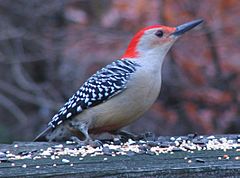Piciformes facts for kids
Quick facts for kids Piciformes |
|
|---|---|
 |
|
| Male red-bellied woodpecker, (Melanerpes carolinus) |
|
| Scientific classification | |
| Kingdom: | |
| Phylum: | |
| Class: | |
| Order: |
Piciformes
|
| Suborders and families | |
|
|
Piciformes are a fascinating group of birds that includes well-known birds like woodpeckers and toucans. There are over 400 different kinds, or species, of Piciformes. About half of these are woodpeckers and their close relatives. Most birds in this group live in forests and spend a lot of time in trees.
Most Piciformes eat insects. However, some, like barbets and toucans, mostly eat fruit. Honeyguides are very special because they are one of the few birds that can digest beeswax! Even so, insects still make up most of their diet.
Almost all Piciformes have unique feet called zygodactyl feet. This means they have two toes pointing forward and two toes pointing backward. This special foot shape helps them grip tree trunks and branches very well. A few woodpeckers are different and only have three toes. Unlike many other birds, Piciformes do not have soft down feathers at any age. They only have their regular feathers.
These birds come in many sizes. The smallest is the rufous piculet, which is only about 8 centimeters (3 inches) long and weighs just 7 grams (about the weight of a few paper clips). The largest is the toco toucan, which can be up to 63 centimeters (25 inches) long and weigh 680 grams (about 1.5 pounds). All Piciformes build their nests in holes or cavities, usually in trees. Their young are altricial, meaning they are born helpless and need their parents to care for them for a long time.
Contents
What are Piciformes?
Piciformes are an order of birds. This is a big group in how scientists classify living things. This order includes several different families of birds, each with its own unique features.
Woodpeckers and Their Relatives
The largest family in the Piciformes order is the Picidae family. This family includes:
- Woodpeckers: Known for pecking holes in trees to find insects and build nests.
- Piculets: Small, woodpecker-like birds.
- Wrynecks: Birds that can twist their necks in unusual ways.
Woodpeckers are famous for their strong beaks and special skulls that protect their brains when they drum on trees. They use their long, sticky tongues to catch insects hidden deep inside wood.
Toucans and Barbets
Another well-known group in the Piciformes order includes toucans and barbets.
- Toucans: These birds are famous for their very large, colorful beaks. Despite their size, these beaks are surprisingly light. Toucans mainly eat fruit.
- Barbets: These birds get their name from the bristles or "barbs" around their beaks. They are often brightly colored and also mostly eat fruit. There are different types of barbets found in Asia, Africa, and the Americas.
Honeyguides
Honeyguides are a unique family of birds in the Piciformes order. They are found in Africa and Asia. They are known for their special ability to digest beeswax. Some species of honeyguides are even known to guide humans or honey badgers to beehives, hoping to get some of the leftover wax and larvae after the hive is opened.
Jacamars and Puffbirds
The Piciformes order also includes jacamars and puffbirds.
- Jacamars: These are colorful, insect-eating birds found in Central and South America. They often sit still on branches, waiting to dart out and catch flying insects.
- Puffbirds: Also found in the Americas, puffbirds are named for their fluffy feathers. They are usually quiet birds that wait patiently for insects to fly by.
Classification of Piciformes
Scientists organize the Piciformes order into smaller groups to show how the different birds are related.
Order: PICIFORMES
- Suborder Galbuli
- Family Galbulidae – jacamars (18 species)
- Family Bucconidae – puffbirds, nunbirds and nunlets (around 30 species)
- Suborder Pici
- Infraorder Ramphastides
- Family Megalaimidae – Asian barbets (about 25 species)
- Family Lybiidae – African barbets (about 40 species)
- Family Capitonidae – American barbets (about 15 species)
- Family Semnornithidae – toucan-barbets (2 species)
- Family Ramphastidae – toucans (about 40 species)
- Infraorder Picides
- Family Indicatoridae – honeyguides (17 species)
- Family Picidae – woodpeckers, piculets and wrynecks (over 200 species)
- Infraorder Ramphastides
Images for kids
See also



